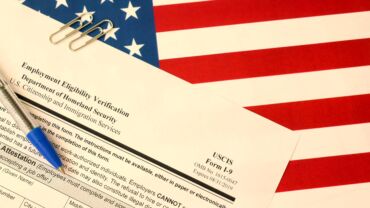Consolidated Appropriations Act, 2023, Pub. L. No. 117-328 (Dec. 29, 2022)
Available at https://www.congress.gov/117/bills/hr2617/BILLS-117hr2617enr.pdf
Congress has passed, and the President has signed, the Consolidated Appropriations Act, 2023 (CAA, 2023), containing provisions that affect both retirement and group health plans. Retirement plan provisions are set forth in a portion of CAA, 2023 known as the SECURE 2.0 Act of 2022 (SECURE 2.0), as some elements build on provisions in the original Setting Every Community Up for Retirement Enhancement Act (original SECURE Act—see our Checkpoint article). Highlights for 401(k) plans include the following:
-
Automatic Enrollment for New 401(k) Plans. Effective for plan years beginning after December 31, 2024, 401(k) plans must qualify as automatic enrollment plans under Code § 414(w)(3) and must provide for automatic contributions of at least 3% and not more than 10% during a participant’s first year of participation, unless the participant elects otherwise, with automatic annual 1% increases to at least 10% but not more than 15% (again, unless otherwise elected). Permissible withdrawals must be allowed within the first 90 days of participation and, absent a participant investment election, automatically contributed amounts must be invested under the rules for qualified default investment alternatives. Automatic enrollment is not required for SIMPLE 401(k) plans, plans established before December 29, 2022, governmental plans, and plans maintained by employers in existence for fewer than three years (including any predecessor employer) or that employ ten employees or fewer. For multiple employer plans, the automatic enrollment requirements and exceptions are applied separately to each employer.
-
Required Minimum Distributions.
-
Beginning Date. The age used to determine when required minimum distributions (RMDs) begin increases from 72 to 73 beginning January 1, 2023 (for individuals who attain age 72 after December 31, 2022, and age 73 before January 1, 2033), and to 75 beginning January 1, 2033 (for individuals who attain age 74 after December 31, 2032). [EBIA Comment: The statutory language creates confusion regarding participants born in 1959. These participants will turn 73 prior to January 1, 2033, but will also turn 74 after 2032, creating RMD ages of both 73 and 75. This might require a technical correction.]
-
Surviving Spouses. Effective for calendar years beginning after December 31, 2023, if an employee who dies before RMDs have begun has designated a spouse as sole beneficiary, the surviving spouse may elect to be treated as the employee under the RMD rules.
-
Reduction of Excise Tax. Effective December 29, 2022, the penalty for failure to take RMDs is reduced from 50% to 25%, with a further reduction from 25% to 10% for failures corrected in a timely manner as defined in the provision.
-
Roth Accounts. Pre-death RMD rules for Roth accounts in employer plans, such as 401(k) plans, are eliminated effective for taxable years beginning after December 31, 2023. [EBIA Comment: This change does not affect RMDs relating to 2023 or earlier years that are permitted to be paid after 2023.]
-
-
Deferrals and Contributions.
-
Roth Requirement for Certain Catch-Up Contributions. Beginning in 2024, catch-up contributions by participants whose wages from the employer for the preceding calendar year exceeded $145,000 (as indexed) are treated as Roth contributions. [EBIA Comment: Currently, plans need not offer participants the opportunity to make designated Roth contributions. However, plans with affected participants will be required to offer and administer Roth contributions.]
-
Catch-Up Limit. Beginning in 2025, the catch-up contribution limit is increased to the greater of $10,000 ($5,000 for SIMPLE plans) or 50% more than the 2024 regular catch-up limit (2025 for SIMPLE plans) for individuals who attain ages 60, 61, 62, or 63 during the year. The dollar amounts are indexed for inflation.
-
Employer Roth Contributions. Effective for contributions made after December 29, 2022, 401(k) plans may permit participants to designate some or all fully vested matching contributions and nonelective contributions as Roth contributions.
-
Student Loan Payments. For plan years beginning after December 31, 2023, employers may make matching contributions under a 401(k) plan with respect to “qualified student loan payments,” which are defined as employees’ repayments of qualified educational loans incurred to pay qualified higher education expenses. Employees must certify annually that they have made these payments, and the amount matched may not exceed the Code § 402(g) annual deferral limit for the year. Separate nondiscrimination testing is permitted for employees receiving matching contributions on student loan repayments.
-
Incentives. For plan years beginning after December 29, 2022, employers may offer de minimis financial incentives to encourage 401(k) plan participation. Incentives cannot be paid for with plan assets. [EBIA Comment: “De minimis financial incentive” is undefined. The Senate Finance Committee’s Section-by-Section Summary of SECURE 2.0 mentions low-dollar gift cards as an example. Official guidance is needed.]
-
-
Withdrawals and Loans.
-
Penalty-Free Withdrawals. SECURE 2.0 provides additional exceptions to the 10% additional tax for early distributions for: (1) withdrawals of up to the lesser of $10,000 (indexed) or 50% of the participant’s account balance by participants who self-certify that they experienced domestic abuse; (2) withdrawals of up to $1,000 for unforeseeable or immediate financial needs relating to necessary personal or family emergency expenses; and (3) early distributions made on or after the date on which an employee has been certified by a physician as having a terminal illness. The exceptions have different effective dates and varying details (e.g., regarding certification, timing, and repayment). Plan sponsors may amend their plans to permit in-service withdrawals in cases of domestic abuse or for emergency expenses without causing the plan to become disqualified. [EBIA Comment: The exception for withdrawals by terminally ill participants does not specifically permit plan amendments to make terminal illness an in-service distribution event. As such, 401(k) plan sponsors must be certain that such a distribution is otherwise permissible under existing terms of the plan (e.g., it constitutes a distribution event for 401(k) purposes, at least with respect to any elective deferral amounts to be distributed.)]
-
Employee Certifications. For plan years beginning after December 29, 2022, employers may rely on employees’ self-certifications regarding events that constitute hardships under the rules. [EBIA Comment: Regulations already allow employers to rely on self-certifications for certain elements of the hardship withdrawal rules. The change allows broad reliance by employers that all requirements are met.]
-
Withdrawals for Qualified Birth or Adoption Expenses. Effective for distributions made after December 29, 2022, participants have three years to repay withdrawals for qualified birth or adoption expenses. For withdrawals already taken, the repayment period ends on December 31, 2025. [EBIA Comment: Before this change, repayments could be made at any time.]
-
Qualified Federally Declared Disasters. A “qualified disaster recovery distribution” of up to $22,000 from a 401(k) plan is not subject to the 10% additional tax for early distributions and, unless the participant elects otherwise, is included in income over three years. Also, the limit on disaster-related 401(k) plan loans is increased to the lesser of $100,000 or 100% of a participant’s vested balance. And participants with plan loan payments due within 180 days after a disaster are eligible for a one-year repayment delay and corresponding payment deadline extension. These provisions apply to disasters for which the incident period begins on or after January 26, 2021.
-
-
Automatic Rollover Limit. Effective for distributions made after December 31, 2023, the dollar limit for automatic rollovers into IRAs (sometimes called mandatory cash-out distributions) is increased from $5,000 to $7,000.
-
Long-Term Part-Time Employees. For plan years beginning after December 31, 2024, part-time employees must be allowed to make elective deferrals after attaining age 21 and completing at least 500 hours per year with the employer for two or more consecutive years. (This is a reduction from the three-year period currently in effect under the original SECURE Act; see our Checkpoint article.) SECURE 2.0 also clarifies that periods beginning before January 1, 2021, are disregarded for vesting purposes, as well as for determining whether employees have completed the necessary years of service, and that a 401(k) safe harbor plan that is eligible for an exemption from the top-heavy rules does not fail to qualify for the exemption merely because the plan does not provide safe harbor matching contributions to long-term part-time employees. These clarifications are effective as if included in the original SECURE Act.
-
Changes to Notice Requirements. For plan years beginning after December 31, 2022, participants who elect not to participate and have already received an SPD and any other notices regarding initial eligibility to participate (unenrolled participants) need not receive intermittent plan-related notifications (e.g., disclosures, notices, and plan documents). Unenrolled participants must still receive annual reminder notices of their eligibility to participate (specifying any election deadlines), and requested documents to which they would otherwise be entitled.
-
EPCRS Expansion. Effective December 29, 2022, self-correction under the Employee Plans Compliance Resolution System (EPCRS) is expanded to cover any “eligible inadvertent failure” to comply with the Code § 401(a) rules, unless the error is identified by the Treasury Secretary before any actions have been taken demonstrating a specific commitment to implement a self-correction, or the self-correction is not completed within a reasonable time after the failure is identified. Eligible inadvertent failures include any failure that occurs despite compliance practices and procedures that satisfy the EPCRS standards and is not egregious, related to the diversion or misuse of plan assets, or related to an abusive tax avoidance transaction. In addition, participant-loan-related errors may be self-corrected in accordance with specified EPCRS rules. Loan failures self-corrected in accordance with applicable requirements will be treated as meeting the requirements of the DOL’s Voluntary Fiduciary Correction (VFC) Program, although the DOL may impose reporting or other procedural requirements. SECURE 2.0 also requires the issuance of guidance on correction methods and general principles of correction; EPCRS must be revised for these changes by December 29, 2024.
-
Emergency Savings Accounts. Effective for plan years beginning after December 31, 2023, SECURE 2.0 permits plan sponsors to amend their 401(k) plans to establish “pension-linked emergency savings accounts” for non-highly compensated employees. These accounts would have an annual contribution cap equal to the lesser of $2,500 (indexed) or an amount selected by the plan sponsor, and contributions would be made on a Roth basis. Among other requirements, emergency savings accounts must be held in cash or certain other investment forms consistent with the need for liquidity.
-
Extended Amendment Period and Anti-Cutback Relief. The deadline for plan amendments made pursuant to SECURE 2.0 (or regulations thereunder) is the end of the first plan year beginning on or after January 1, 2025 (2027 for governmental and collectively bargained plans). If, in the interim, a plan operates as if a retroactive amendment were already in effect, the amendment will not be treated as violating the anti-cutback rules (unless otherwise provided in IRS guidance). Certain plan amendment deadlines under the original SECURE Act and other legislation are also conformed to these new dates. [EBIA Comment: There may be some differences in how the extended deadlines for earlier changes apply to certain plans, particularly governmental and collectively bargained plans.]
SECURE 2.0 also addresses “starter 401(k) deferral-only arrangements” and retroactive elective deferrals for sole proprietors for a plan’s first year.
EBIA Comment: There is much to digest here for those who work with employee benefit plans. (For non-retirement items, see our separate Checkpoint article.) Plan sponsors and advisors will need to quickly familiarize themselves with the legislation’s many required and optional provisions—including various effective dates. For more information, see EBIA’s 401(k) Plans manual at Sections VIII (“Contributions: Participant”), IX (“Contributions: Employer”), XII (“Distributions: Code Requirements and Design Choices”), XV (“Distributions: Hardship”), XVI (“Distributions: Participant Loans”), XXVII (“Plan Administration: Adoption, Amendment, Submission”), and XXXV (“Correcting Plan Mistakes: IRS’s EPCRS”).
Contributing Editors: EBIA Staff.









